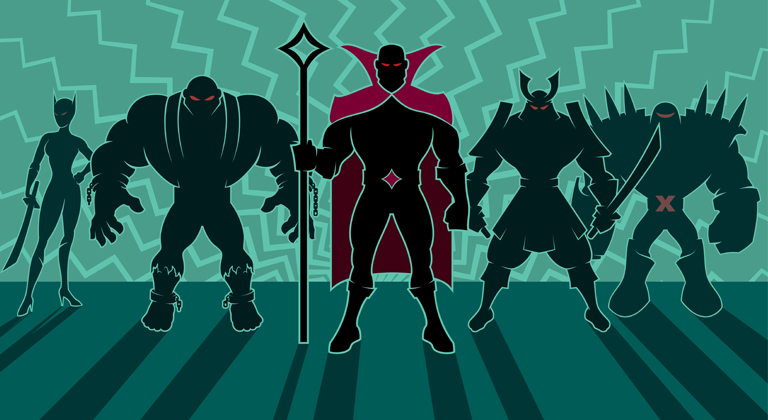5 Tips for Crafting Deliciously Memorable Villains
As much as we know we’re supposed to root against them, there is something undeniably alluring to a well-crafted villain. Perhaps it’s because we’re drawn to these complex, competent, and often morally ambiguous antagonists who challenge our heroes and help intensify the drama in whatever type of story they appear in. But creating memorable villains is an art, so in today’s blog, Ginger is attempting to unravel some of the secrets that help make our bad guys truly unforgettable.
From the complex backstory of Hannibal Lecter to the moral ambiguity of Jaime Lannister, these villains have distinct traits, personality quirks, and compelling motivations that make them uniquely suited to causing havoc in our stories. When done right, these characters will linger in the minds of our readers, which is the best way to keep them coming back for more!
Whether it’s Lord Voldemort, Darth Vader, or HAL 2000, one thing is clear – we all love a good villain. The more complex, colorful and competent a bad guy (or girl) is, the more of a challenge they pose to our heroes and heroines – elevating the stakes of any adventure story, mystery, or thriller.
But how do you go about crafting a deliciously memorable villain? I studied five of the greatest literary bad-guys of all time and identified the five most important traits that I think are vital for creating one of those characters you “love to hate.”
If you’re aspiring to write a book with a truly terrible antagonist (and I mean “terrible” in all the right ways) you’ll hopefully find some of these observations useful.
#1 Complex Motivations
One of the most important aspects of a memorable villain is their motivation. A one-dimensional, purely evil character is unlikely to resonate with readers. Instead, authors should strive to make their antagonist’s motivations complex, relatable, and perhaps not entirely unsympathetic. (The phrase “Thanos was right” became popular for a reason!)
Consider the character of Severus Snape from J.K. Rowling’s Harry Potter series. At first, Snape appears to be a typical villain, antagonizing Harry and his friends. However, as the story unfolds, it becomes clear that his motivations are deeply rooted in his past and his unrequited love for Lily Potter, Harry’s mother.
Snape’s character is a prime example of how complex motivations can transform a villain into a multi-dimensional character. By gradually revealing the layers of your antagonist’s motivations, you create a more engaging and memorable character who some readers might even end up rooting for.
#2 Moral Ambiguity
A villain who is not entirely evil but rather morally ambiguous can be far more intriguing than an out-and-out, moustache-twirling bad guy. Readers love to grapple with the question of whether the antagonist’s actions are justified or understandable. A classic example of this is the character of Jamie Lannister from George R.R. Martin’s A Song of Ice and Fire series (especially as portrayed by Nikolaj Coster-Waldau in the Game of Thrones television adaptation.
Jamie starts as a character reviled for his actions, such as pushing Bran Stark from a tower. However, as the series progresses, his backstory and personal struggles make him a more nuanced and even sympathetic character. His complex morality keeps readers and viewers engaged, as they become unsure whether to love or hate him. Creating a morally ambiguous villain allows for a thought-provoking exploration of ethics and human nature, making the character unforgettable (and their story sometimes even more compelling than that of the hero!)
#3 Distinct Personality and Quirks
Villains that stand out often possess unique and memorable traits that set them apart from the typical antagonist. These distinctive characteristics can make the character more interesting and recognizable. The Joker, as depicted in various Batman comics, films, and television shows, is perhaps the greatest example of a villain with a distinctive personality and a variety of quirks.
Although there have been dozens of adaptations of the character, some elements remain consistent throughout. The Joker’s signature green hair, clown-like appearance, and chaotic, unpredictable behavior make him instantly recognizable, whether you’re watching Christopher Nolan’s The Dark Knight movie, or Batman: The Animated Series. His distinctive laughter and penchant for chaos set him apart from other comic book villains. When crafting your own memorable villain, consider what traits, quirks, or habits could make them unique. These idiosyncrasies not only make the character more intriguing but also leave a lasting impression on your readers.
#4 Compelling Backstory
While we’re on the topic of DC villains, there’s a reason the DC universe has better bad guys than the Marvel Cinematic Universe – their backstory. Every great villain has a compelling backstory that sheds light on their motivations and actions – whether it’s Doctor Cold trying to save his wife from a terminal illness, or Two Face struggling with the trauma of an attack which destroyed half his face.
The same is true for all truly memorable bad guys. Exploring a character’s past can add depth and complexity to your antagonist. In the Hannibal Lecter series by Thomas Harris, the eponymous villain Hannibal Lecter is a prime example of a character with a captivating backstory (and isn’t he just the most perfect literary bad guy?)
Hannibal Lecter’s childhood experiences and the trauma he endured help explain his psychopathic tendencies. Learning about his past makes readers understand, if not sympathize with, his actions. A well-crafted backstory can provide insights into why the villain became who they are and why they pursue their goals, in addition to humanizing the antagonist and adding depth to their character.
#5 Foil to the Protagonist
The fifth and final trait to a memorable villain is one of my favorites – how a memorable villain should always be a foil to the protagonist. They should challenge the hero in a way that tests their character, skills, and beliefs. This conflict between the protagonist and antagonist can be what drives the story’s tension along and keeps readers engaged throughout.
Perhaps there’s no better example to be found than in Arthur Conan Doyle’s Sherlock Holmes series. In those stories, the cunning and brilliant Professor Moriarty serves as a classic example of a foil to the detective Holmes.
Moriarty’s intelligence and calculated criminal activities create a formidable obstacle for Holmes, making their encounters thrilling and intellectually stimulating. To create a memorable villain, consider how your antagonist can directly oppose the protagonist, pushing them to their limits and forcing them to grow and evolve.
Conclusion
Crafting a memorable villain is a vital element of storytelling. By incorporating complex motivations, moral ambiguity, distinct personality and quirks, a compelling backstory, and making them a foil to the protagonist, you can create a character that lingers in the minds of your readers long after they’ve turned the final page.
Hopefully you’ll find some inspiration from the examples I provided – and the dastardly behavior of Severus Snape, Jamie Lannister, the Joker, Hannibal Lecter, and Moriarty can guide you in developing a truly compelling antagonist that adds depth and intrigue to your narrative (and leaves a lasting impact on your audience!)












Interesting article thank you!